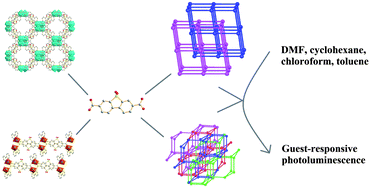Four new metal–organic frameworks constructed from H2DBTDC-O2 (H2DBTDC-O2 = dibenzothiophene-5,5′-dioxide-3,7-dicarboxylic acid) ligand with guest-responsive photoluminescence†
Abstract
Four new metal–organic frameworks (MOFs):

* Corresponding authors
a
Hefei National Laboratory for Physical Science at Microscale, CAS Key Laboratory of Soft Matter Chemistry and Department of Chemistry, University of Science and Technology of China, Hefei, P. R. China
E-mail:
zwang3@ustc.edu.cn
Fax: + 86-551-3603185
Tel: + 86-551-3603185
Four new metal–organic frameworks (MOFs):

 Please wait while we load your content...
Something went wrong. Try again?
Please wait while we load your content...
Something went wrong. Try again?
S. Xiong, S. Wang, X. Tang and Z. Wang, CrystEngComm, 2011, 13, 1646 DOI: 10.1039/C0CE00422G
To request permission to reproduce material from this article, please go to the Copyright Clearance Center request page.
If you are an author contributing to an RSC publication, you do not need to request permission provided correct acknowledgement is given.
If you are the author of this article, you do not need to request permission to reproduce figures and diagrams provided correct acknowledgement is given. If you want to reproduce the whole article in a third-party publication (excluding your thesis/dissertation for which permission is not required) please go to the Copyright Clearance Center request page.
Read more about how to correctly acknowledge RSC content.
 Fetching data from CrossRef.
Fetching data from CrossRef.
This may take some time to load.
Loading related content
